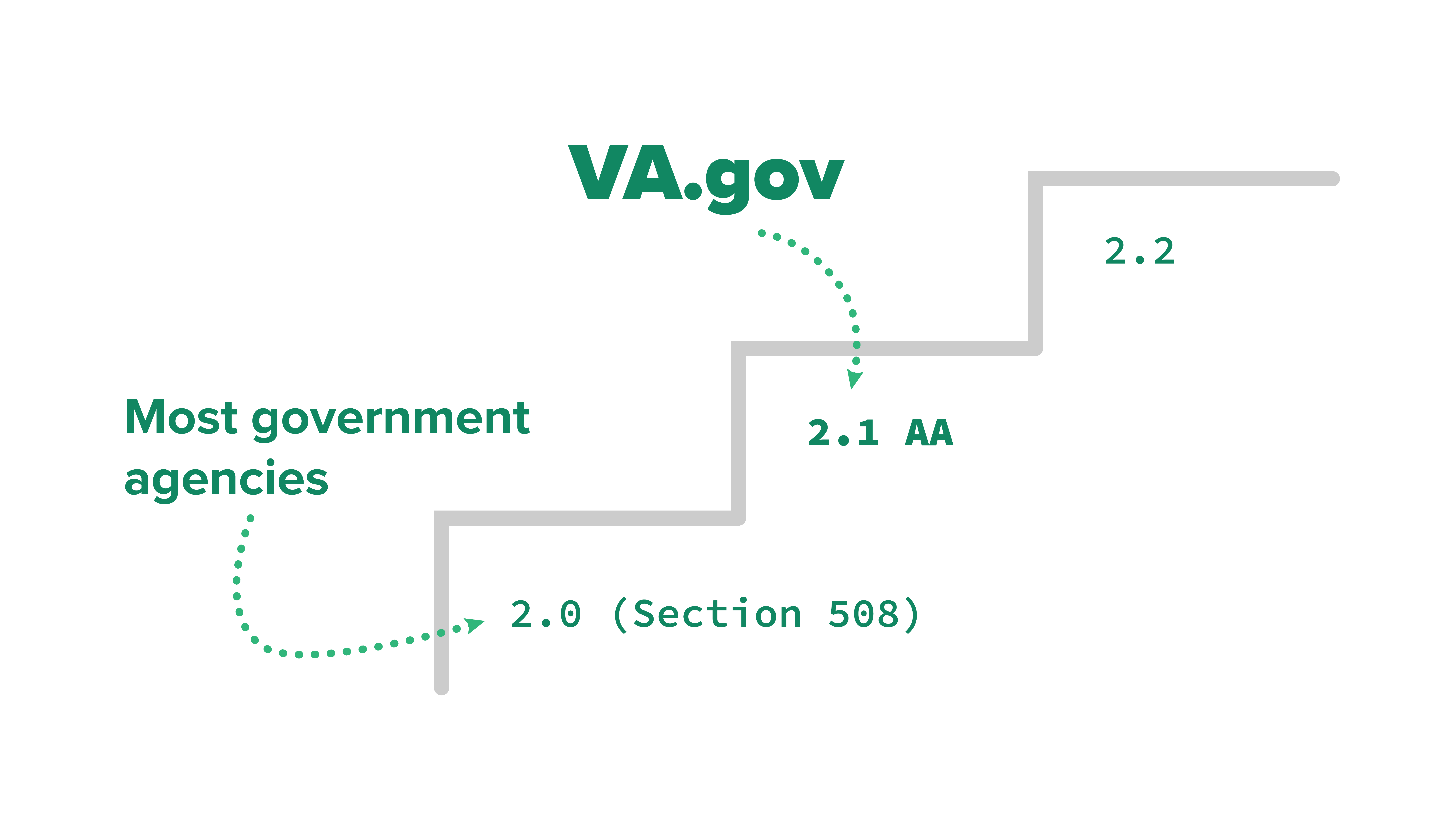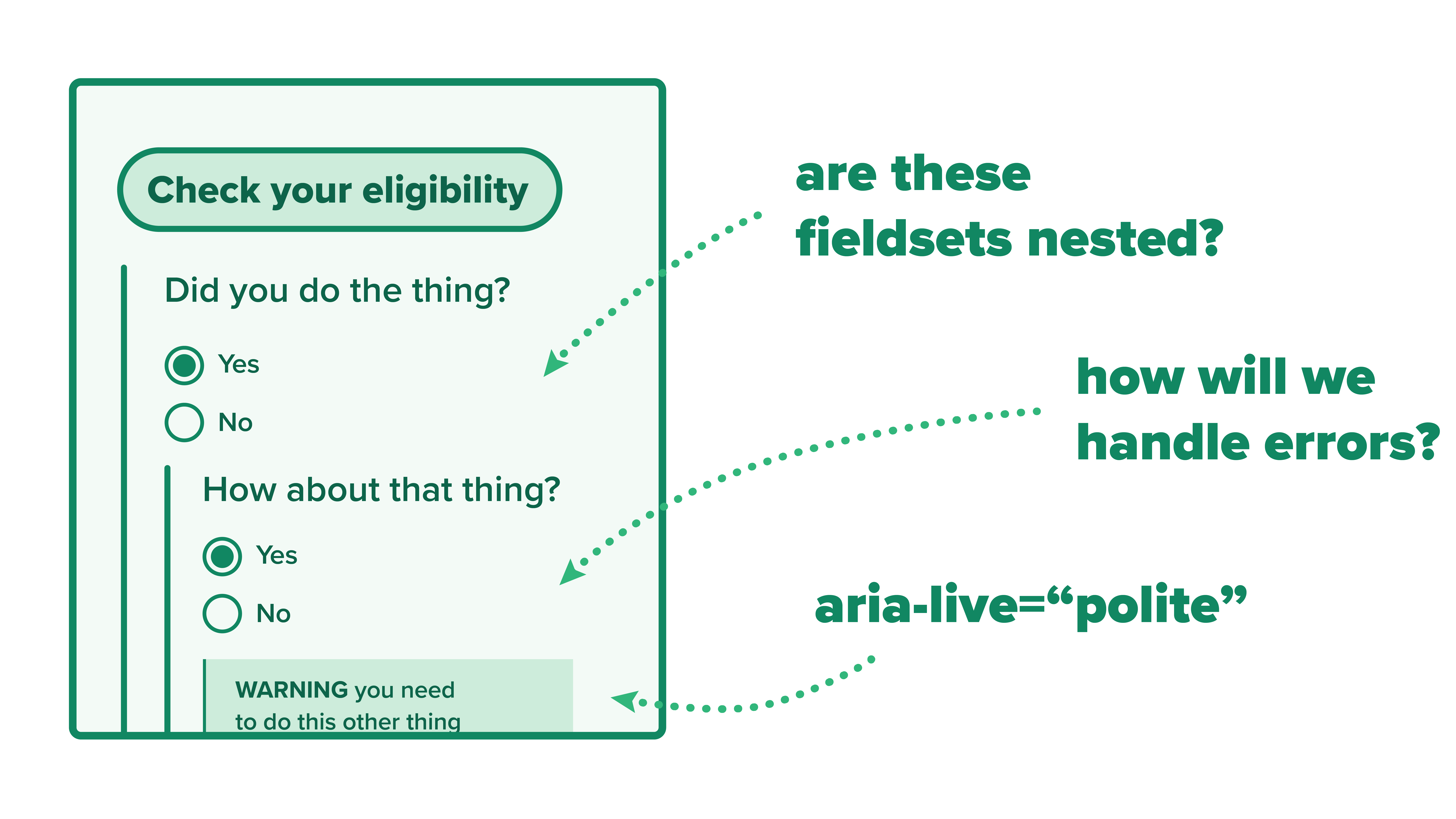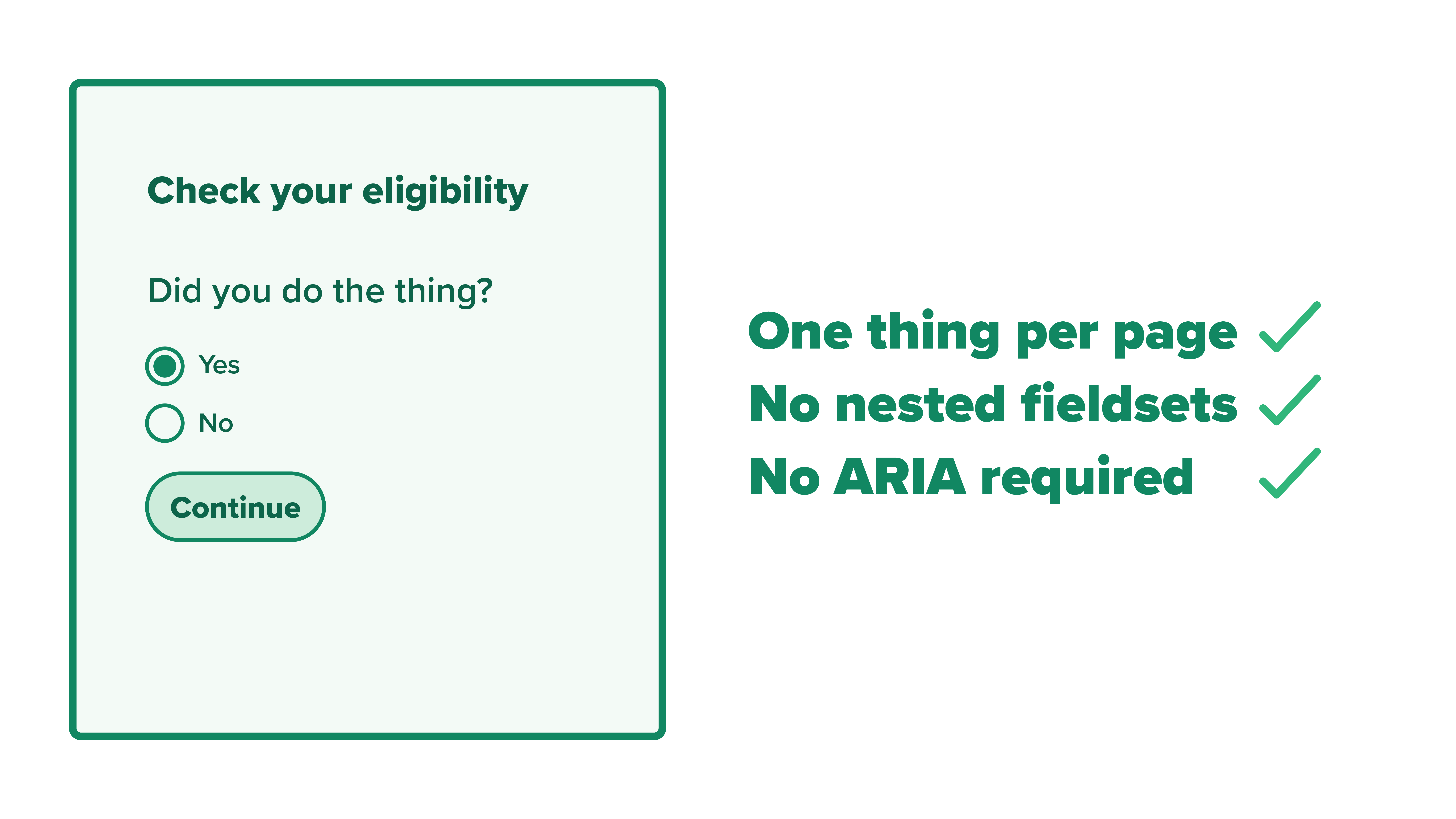Scaling accessibility compliance at VA.gov through community and culture
The authors want to specifically call out and uplift the efforts of Angela Fowler, Jeana Clark, Tiffany Pender, and Brian DeConinck in making the work, and consequentially this article, possible. While we may have written the words below, the work belongs to all of us as a team.
In this article, we’ll break down the benefits of compliance framing and show how we centered our work around the disabled Veteran experience, which helped lead to measurable improvements at VA.gov.
Shifting perspective for even greater accessibility compliance gains
From the beginning, much of the groundwork for accessibility compliance was already in place at VA.gov – from automated testing to defined standards for manual testing. In fact, VA.gov had one of the most robust compliance testing programs in government. If we were to imagine compliance as a staircase, VA.gov was a step ahead of most government agencies, having moved its standards to WCAG 2.1 AA, establishing sitewide automated accessibility compliance testing, and formalizing a replicable manual testing process.

Logically, the next step for most would be to begin preparing for the next set of compliance standards (WCAG 2.2), but we saw an opportunity to shift perspectives toward a new approach centered on the disabled Veteran experience. Why? Let’s look at an example of a building ramp for disabled access.
Just because a ramp is built to meet compliance standards, accounting for the correct incline and distance, doesn’t mean that the ramp is accessible. The ramp has to be situated within a larger, accessible context to provide a benefit.

Similarly, we wanted to ensure that VA.gov products would be both compliant and provide a frictionless experience for disabled Veterans.
The benefits of compliance framing
We use accessibility compliance to explore, understand, and better address the needs of the full, complex, and intersectional diversity of the disabled experience.

Improved cost and time savings
One benefit of the accessibility compliance approach is that it saves money and time by reducing the amount of downstream issues that need remediation after launch.
Take designing a form as an example. If we conduct accessibility work after a form has been designed and built, we might end up with long, complicated pages that require an overwhelming amount of post hoc fixes.

But if we start thinking about accessibility from the kickoff, include disabled Veterans in our research, and allow accessibility to guide how we design the content and structure of the form, we can significantly reduce the amount of expensive, launch-blocking defects caught later right before a stressful launch.

You might be wondering, “what does this do for time to launch?”
An accessibility compliance approach will require more effort earlier in the product development life cycle but will also significantly reduce the total time and cost required later during development, testing, production, and post-launch fixes. We can frame this in terms of how many people might be involved with either approach.
Catching a major defect at the design stage
According to Deque, 67% of accessibility defects originate in design. Using a compliance approach, we can catch and resolve those issues early with low involvement from the team.
- Designers explore alternative approaches in a low-risk environment.
- Accessibility compliance specialists support and guide designers.
Catching a major defect in production
Conversely, postponing accessibility work later in the product life cycle will result in issues snowballing into problems that can immediately impact disabled people and require entire teams to resolve.
- Disabled people can’t access the product.
- Accessibility compliance specialists test, document, and offer solutions for the issue.
- Product managers scope the fix, write user stories and acceptance criteria, and assign the work.
- Designers redesign components and test the changes.
- Engineers update code.
- QA analysts verify the new code doesn’t have other unanticipated consequences.
When defects are identified earlier, fewer people will have to be engaged in solving the problem. That means more people can be focused on other valuable work.
Start with alignment and metrics
To kick off, we focused on building the conditions needed for success. Specifically, that meant:
- Aligning and training teams for accessibility compliance
- Standardizing success metrics that produce accessible outcomes
Establishing an accessibility compliance practice
We started our alignment work locally by co-creating an accessibility practice with our small team of existing and new specialists. This ensured we were building alignment across existing work, instead of replacing previous efforts or standards.
We co-designed a new weekly sync, collaborated on community guidelines, established internal office hours, and invested in improving how we worked with each other. This helped build the conditions needed for safety and trust to confidently begin discovery into our existing pain points, opportunities, and long-term goals as a group. We began to operate as a practice, a collection of individuals on different teams brought together by common goals.
During this process, we paid special attention to how we selected the tools we would use to ensure that current and future disabled team members wouldn’t need to require accommodations to fully participate in all of our activities. We intentionally tested a suite of different options, and settled on communicating flexibly through a combination of Zoom, Slack, Google Docs, and Google Sheets instead of using less accessible alternatives like GitHub Projects, Trello, and Mural.
Expanding our vision collaboratively
Once our accessibility compliance practice achieved internal alignment, we were ready to extend our vision for accessibility compliance across all of VA.gov. We drafted a rough document and invited VA leadership, team members, and the VA Section 508 office to contribute and review.
Over several months, we successfully received constructive feedback, participation, and buy-in for our newly published modernized VA.gov accessibility strategy from more than 30 stakeholders across 7 organizations and 5 disciplines. From this collaboration came the new vision and mission:
- Vision: Every disabled Veteran and caregiver has guaranteed access to equitable, easy to use, self-service tools without needing to request accommodations.
- Mission: Empower product teams to collaborate with disabled Veterans and caregivers by enhancing the culture and tools used to co-create and maintain services that are compliant.
Prioritizing meaningful metrics
As part of expanding our vision, we wanted to make sure the metrics we selected would be responsive to signals indicating we were making meaningful progress toward our mission.
To do this, we facilitated an asynchronous workshop in a Google Sheet to prioritize a list of metrics based on standards established in collaboration with a senior product manager. These included:
- If a metric is comparative
- If a metric could communicate challenges and wins
- If a metric could go down and inspire action
- If a metric was easy to track
- If methods for calculating a metric are decomposable

We narrowed down our list to the following metrics, with documentation on why we selected them, how we’ll monitor them, and how they’re intended to be used:
- Percentage of research studies with the accessibility label
- Percentage of pre-launch reviews with no major accessibility issues
- Percentage of accessibility compliance specialists with a balanced workload
Unlike metrics tied downstream to a count of defects, which may fluctuate based on noise related to the amount of reviews occurring in a quarter, we rationalized that these metrics would provide more actionable signals of upstream success or failure.
Making alignment stick
While a vision, mission, and key metrics can act as a north star, they lose value if they don’t have the community support to put them into practice. To make our alignment sustainable, we turned our attention towards nurturing, growing, and educating communities toward:
- Designing with an accessibility-compliant mindset
- Including disabled people in research
- Fostering welcoming cultures and spaces
Evangelizing an accessibility-compliant mindset
We focused heavily on education across VA.gov through coordinating accessibility learning sessions, establishing accessibility office hours, and embedding accessibility compliance specialists onto teams. We also launched a community-driven accessibility compliance champions program, which has grown to 70 members in just 3 months.
We worked closely with the VA.gov community to collect and respond to feedback, develop educational material in the open, and reduce the friction to get accessibility help. Over the course of 8 workshops, we had a 98% approval rating from a mix of designers, developers, and researchers. Through this work, we’ve received some incredibly helpful, encouraging feedback:
This information is always SUPER helpful. I know the teams really try to think about these things, but often just know the basics. Each of these presentations really opens eyes (and ears!) to thinking about these things from so many different perspectives.
The 'assignments' were engaging, and I liked being presented with multiple options and being able to choose what I wanted to do (watch or read or both). The screen reader video was really helpful, and this was the most successful I've felt using a screen reader before on my own without having to ask someone else for help!
Scaling trauma-informed design with disabled Veterans through welcoming communities
We also founded a thoughtfu lresearch and trauma-informed design practice at VA.gov to better enable our vision for co-designing with disabled Veterans.
We started by documenting the absence of disabled and other underserved Veterans through a recruitment checker. We nested this within our default research read-out templates, which helped initiate more conversations and guide more designers into our research community.

Angela Fowler, one of our accessibility compliance specialists, took the lead in embedding within and training up teams through pilot research sessions – and even initiated collaborative efforts with the National Federation of the Blind.
Finally, from our work developing an research community, we established a trauma-informed design community to explicitly mature our approach towards facilitating research with Veterans with trauma. This helped establish new guidance for practitioner safety and care, protocols to give more agency and control to Veterans (like approving the presence of observers on a call), safer spaces for practitioners to debrief, workshops for familiarizing new practitioners on trauma in our work, and more.
Our communities are now more than 150 practitioners strong and have continued to evolve our protocols for more research and trauma-informed design at scale.
Measurable impacts
Since establishing a new vision around accessibility compliance, we’ve seen a number of measurable impacts:
- A twentyfold increase in the representation of disabled Veterans using assistive technology in our research: The VA’s Office of the CTO (OCTO) increased its database of participants who use assistive technology by more than twentyfold in 2022 in partnership with Veteran Service Organizations like the Blinded Veterans Association (BVA). Approximately 12% of OCTO’s research sessions involved assistive technology users.
- Pre-launch accessibility compliance audits without major issues: In 2022, VA.gov had its first pre-launch accessibility audit without any major issues. We measured a 10% total increase in the percentage of pre-launch accessibility audits with no major issues.
- VA.gov’s first Veteran-centered accessibility statement: Thanks to our new vision, our accessibility specialists were able to justify and lead research investigating how disabled Veterans could provide feedback to VA.gov. Our findings made the case for publishing VA.gov’s first-ever Veteran-centered accessibility statement, replacing a 16-year-old Section 508 page.
- More accessibility compliance specialists with balanced workloads: By the end of 2022, we achieved our goal of improving workloads for accessibility specialists by 14%. New community-designed systems of support like our weekly check-ins and office hours helped us better coordinate on larger VA.gov-wide projects and mitigate burnout.
It takes a village
Work at this scale is impossible without the coordination and participation of numerous people and organizations. We want to thank our prime Coforma for sponsoring this work, our OCTO accessibility lead Martha Wilkes for championing our approach, and VA.gov for relentlessly committing to improving its approach towards accessibility compliance. Because of this collaboration, VA.gov will continue to serve as an essential, equitable resource for millions of Veterans, their families, and caregivers.
Related posts
- How to meet the newest WCAG 2.2 requirements
- Become a champion for Section 508 compliance by using annotations
- Using performance testing to build resilient systems for all
- Setting the right benchmarks for site speed in government
- Developing a focus style for a themable design system
- The right benchmarks


